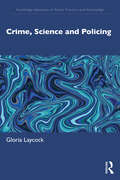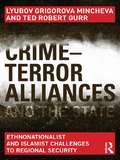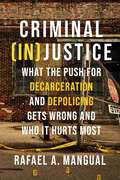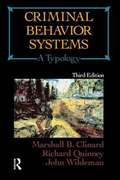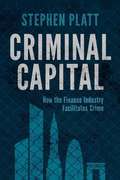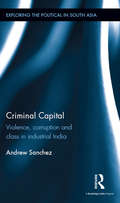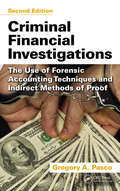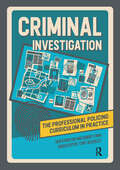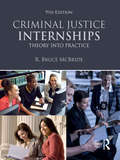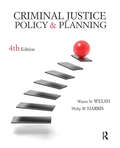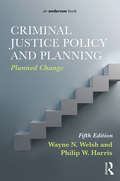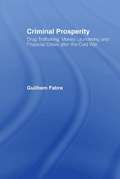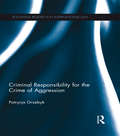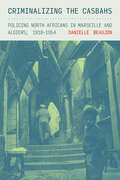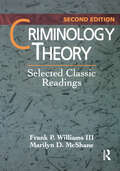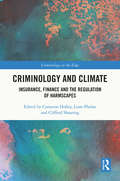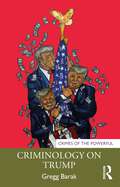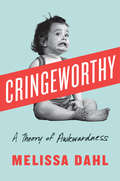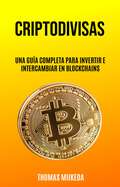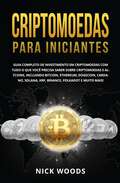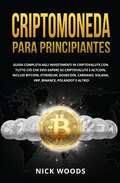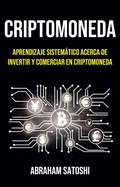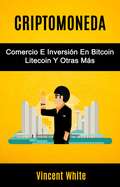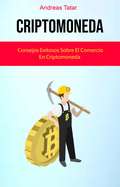- Table View
- List View
Crime, Science and Policing
by Gloria LaycockThis book offers an introduction to crime science; it is specifically for police and security professionals. Written by one of the founders of crime science and an expert in crime reduction, it considers the unique characteristics of the approach, its applicability to the control of crime, disorder and terrorism, and the importance of experimentation and the testing of new ideas to build a knowledge base for ethical policing. Core content includes: The basics of crime science in concept, theory and practice; Methods of research and assessment used by crime scientists; Crime science and policing, including its application to volume crimes, serious crimes and investigation; Legitimacy and public compliance; Policing, science, and future crimes. This book is essential reading for all students of professional policing, as well as those interested in crime and its control, reduction, and prevention.
Crime-Terror Alliances and the State: Ethnonationalist and Islamist Challenges to Regional Security (Contemporary Security Studies)
by Ted Robert Gurr Lyubov Grigorova MinchevaThis book examines the trans-border connections between militant and criminal networks and the relationship between these and the states in which they operate. "Unholy alliances" is a term used to describe hybrid trans-border militant and criminal networks that pose serious threats to security in Europe and elsewhere. Identity networks provide the basis for militant organizations using violent strategies – insurgency and terrorism – for political objectives. To gain funds and weapons militant networks may establish criminal enterprises, or align with existing trans-border criminal and financial networks. This book extends the concept of unholy alliances to include the trans-state criminal syndicates that arise in failed and dysfunctional states, exemplified by Serbia and Bulgaria during their post-Communist transitions. To deal with this complex and unconventional subject, the authors develop a theoretical framework that looks at four kinds of factors conditioning the interaction between the political and the criminal: trans-state identity networks, armed conflict, the balance of market opportunities and constraints, and the role of unstable and corrupt states. The volume also examines actors at two levels of analysis: the structure and activities of militant (and/or criminal) networks, and the policies of state actors that shape and reshape the interaction of opportunities and constraints. This book will be of much interest to students of terrorism, insurgency, transnational crime, war and conflict studies, and IR in general.
Criminal (In)Justice: What the Push for Decarceration and Depolicing Gets Wrong and Who It Hurts Most
by Rafael A. MangualIn his impassioned-yet-measured book, Rafael A. Mangual offers an incisive critique of America's increasingly radical criminal justice reform movement, and makes a convincing case against the pursuit of "justice" through mass-decarceration and depolicing.After a summer of violent protests in 2020—sparked by the deaths of George Floyd, Breonna Taylor, and Rayshard Brooks—a dangerously false narrative gained mainstream acceptance: Criminal justice in the United States is overly punitive and racially oppressive. But, the harshest and loudest condemnations of incarceration, policing, and prosecution are often shallow and at odds with the available data. And the significant harms caused by this false narrative are borne by those who can least afford them: black and brown people who are disproportionately the victims of serious crimes.In Criminal (In)Justice, Rafael A. Mangual offers a more balanced understanding of American criminal justice, and cautions against discarding traditional crime control measures. A powerful combination of research, data-driven policy journalism, and the author's lived experiences, this book explains what many reform advocates get wrong, and illustrates how the misguided commitment to leniency places America's most vulnerable communities at risk. The stakes of this moment are incredibly high. Ongoing debates over criminal justice reform have the potential to transform our society for a generation—for better or for worse. Grappling with the data—and the sometimes harsh realities they reflect—is the surest way to minimize the all-too-common injustices plaguing neighborhoods that can least afford them.
Criminal Behavior Systems: A Typology
by John Wildeman Richard Quinney Marshall R. ClinardAn important classic, especially useful for courses in criminal behavior and personality, this text begins with a discussion of the construction of types of crime and then formulates and utilizes a typology of criminal behavior systems.
Criminal Capital
by Stephen PlattIn the first book to expose the role played by the international financial services industry in facilitating crime and laundering criminal property, one of the world's leading anti-financial crime specialists scrutinises the vulnerability of banks, brokerages, trust companies, and investment funds to criminal abuse. Discover: - How the finance industry enables corruption, drug trafficking, terrorism, human trafficking, proliferation, piracy, and tax evasion - Why extreme and dangerous industry behaviour correlates with the risk taking that toppled the global economy in 2008 - What measures can be taken to prevent criminals from compromising the legitimacy of the global financial system Examining the role of the traditional powerhouse financial centres as well as offshore centres and rapidly emerging international financial centres in the Middle East, Africa, and Asia, this highly informative book challenges the reader to consider whether following the 2008 crisis, sufficient steps have been taken to address toxic behaviours in financial services; or whether radical reform is needed.
Criminal Capital: Violence, Corruption and Class in Industrial India (Exploring the Political in South Asia)
by Andrew SanchezCriminal Capital explores the relationship between neoliberalism, criminality and the reshaping of class in modern India. It discusses how the political vocabularies of urban industrial workers reflect the processes by which power is distributed across the region. Based upon field research among a ‘casualised’ workforce in the industrial city of Jamshedpur, the book examines the links between the decline of employment security, and criminality in trade unions, corporations and the state. The volume compares popular discourses of corruption against the ethnography of local labour politics, business enterprise and debt collection, and shows how corruption and criminality consolidate class power in industrial environments. Using an interdisciplinary ethnographic approach, this study interrogates the relationship between capitalism, corruption, violence and labour politics in contemporary Indian society. An important intervention in the study of Indian political economy, this work will be of interest to scholars and researchers of Indian politics, social anthropology, economics, labour relations and criminology.
Criminal Financial Investigations: The Use of Forensic Accounting Techniques and Indirect Methods of Proof, Second Edition
by Dale L. June Gregory A. PascoUnderstanding the financial motivations behind white collar crime is often the key to the apprehension and successful prosecution of these individuals. Now in its second edition, this volume provides direct instruction on the how to aspects of criminal financial investigations, taking readers through the different approaches used in gathering evidence and demonstrating how to present circumstantial evidence to a judge or jury in a simple and convincing manner. Written by a former Special Agent with the Criminal Investigation Division of the U.S. Internal Revenue Service, the book sets out a methodology enabling readers to identify, pursue, and successfully prosecute white collar crime.
Criminal Futures: Predictive Policing and Everyday Police Work (Routledge Studies in Policing and Society)
by Matthias Leese Simon EgbertThis book explores how predictive policing transforms police work. Police departments around the world have started to use data-driven applications to produce crime forecasts and intervene into the future through targeted prevention measures. Based on three years of field research in Germany and Switzerland, this book provides a theoretically sophisticated and empirically detailed account of how the police produce and act upon criminal futures as part of their everyday work practices. The authors argue that predictive policing must not be analyzed as an isolated technological artifact, but as part of a larger sociotechnical system that is embedded in organizational structures and occupational cultures. The book highlights how, for crime prediction software to come to matter and play a role in more efficient and targeted police work, several translation processes are needed to align human and nonhuman actors across different divisions of police work. Police work is a key function for the production and maintenance of public order, but it can also discriminate, exclude, and violate civil liberties and human rights. When criminal futures come into being in the form of algorithmically produced risk estimates, this can have wide-ranging consequences. Building on empirical findings, the book presents a number of practical recommendations for the prudent use of algorithmic analysis tools in police work that will speak to the protection of civil liberties and human rights as much as they will speak to the professional needs of police organizations. An accessible and compelling read, this book will appeal to students and scholars of criminology, sociology, and cultural studies as well as to police practitioners and civil liberties advocates, in addition to all those who are interested in how to implement reasonable forms of data-driven policing.
Criminal Investigation (The Professional Policing Curriculum in Practice)
by Iain Stainton Robert EwinCriminal investigation is an essential topic, running through the new national policing curriculum from volume crime to serious organised criminality. This book provides accessible and comprehensive coverage, with case studies and examples to embed understanding, clear links between theory and practice, and a range of critical thinking and review activities. It examines investigation from inception to conclusion, detailing methods, explaining legal requirements and reflecting on past investigations. The contributory roles of specialists and forensic support are examined to provide an inclusive overview of the whole investigative process.The Professional Policing Curriculum in Practice is a new series of books that match the requirements of the new pre-join policing qualifications. The texts reflect modern policing, are up-to-date and relevant, and grounded in practice. They reflect the challenges faced by new students, linking theory to real-life operational practice, while addressing critical thinking and other academic skills needed for degree-level study.
Criminal Justice Internships: Theory Into Practice
by R. Bruce McbrideCriminal Justice Internships: Theory Into Practice, 8th Edition, guides the student, instructor, and internship site supervisor through the entire internship process, offering advice and information for use at the internship site as well as pre-planning and assessment activities. With more and more students engaging in internships as a means of enhancing their credentials, the internship has become a defining educational moment. Students learn basics such as choosing an internship site at either a public agency or a private firm, résumé writing techniques, effective use of social networks, interviewing skills, and the importance of setting and developing goals and assessing progress. It also serves as a reference tool for professors and supervisory personnel who assist and supervise the student during the experience. Key Features Addresses the needs of students, administrators, and criminal justice internship supervisors in one resource. Chapters end with practical exercises, such as: preparing for your internship; thinking about your internship placement; planning your internship; your role as an intern; political, economic, and legal factors at your site; assessing your internship. Covers online presence concerns to help students succeed in the age of social media, including protecting one's reputation and using LinkedIn effectively. Includes sample résumés and cover letters. Maintains an important focus on ethics in the workplace through all phases of the internship experience. Outstanding suite of ancillaries, including links to internship sites, Ethics-in-Practice Scenarios and Forms and Resources for students, and Instructor's Notes, Sample Syllabi, midterm questions, links to internship sites, and PowerPoint Lecture slides for instructors.
Criminal Justice Policy and Planning
by Philip W. Harris Wayne N. WelshUnlike other textbooks on the subject, Criminal Justice Policy and Planning presents a comprehensive and structured account of the process of administering planned change in the criminal justice system. Welsh and Harris detail a simple yet sophisticated seven-stage model, which offers students and practitioners a full account of program and policy development from beginning to end. The authors thoughtfully discuss the steps: analyzing a problem; setting goals and objectives; designing the program or policy; action planning; implementing and monitoring; evaluating outcomes; and reassessing and reviewing. Within these steps, students and policy-makers focus on performing essential procedures, such as conducting a systems analysis, specifying an impact model, identifying target populations, making cost projections, collecting monitoring data, and performing a meta-analysis, In reviewing these steps and procedures, readers can develop a full appreciation for the challenges inherent in the process and understand the tools required to meet those challenges. To provide for a greater understanding of the material, the text uses a wide array of real-life case studies and examples of programs and policies. Examples include policies such as Restorative Justice, The Second Chance Act, Three Strikes Laws, and the Brady Act, and programs such as drug courts, boot camps, and halfway houses. By examining the successes and failures of these innovations, the authors demonstrate both the ability of rational planning to make successful improvements and the tendency of unplanned change to result in undesirable outcomes. The result is a powerful argument for the use of logic, deliberation, and collaboration in criminal justice innovations.
Criminal Justice Policy and Planning: Planned Change
by Philip W. Harris Wayne N. WelshUnlike other textbooks on the subject, Criminal Justice Policy and Planning: Planned Change, Fifth Edition, presents a comprehensive and structured account of the process of administering planned change in the criminal justice system. Welsh and Harris detail a simple yet sophisticated seven-stage model, which offers students and practitioners a full account of program and policy development from beginning to end. The authors thoughtfully discuss the steps: analyzing a problem; setting goals and objectives; designing the program or policy; action planning; implementing and monitoring; evaluating outcomes; and reassessing and reviewing. Within these steps, students focus on performing essential procedures, such as conducting a systems analysis, specifying an impact model, identifying target populations, making cost projections, collecting monitoring data, and performing evaluations. In reviewing these steps and procedures, students can develop a full appreciation for the challenges inherent in the process and understand the tools that they require to meet those challenges. To provide for a greater understanding of the material, the text uses a wide array of real-life case studies and examples of programs and policies. Examples include policies such as Restorative Justice, Justice Reinvestment, Stop-and-Frisk, and the Brady Act, and programs such as drug courts, community-based violence prevention, and halfway houses. By examining the successes and failures of various innovations, the authors demonstrate both the ability of rational planning to make successful improvements and the tendency of unplanned change to result in undesirable outcomes. The result is a powerful argument for the use of logic, deliberation, and collaboration in criminal justice innovations.
Criminal Prosperity: Drug Trafficking, Money Laundering and Financial Crisis after the Cold War
by Guilhem FabreDrug trafficking is the most visible part of the profits of organized crime, which have grown considerably since the end of the cold war. The mirror of history shows us the impact of the drug trade in the colonization of Asia. The post cold war geopolitical context reproduces elements of the past, with new opportunities for drug trafficking in the globalization process, as can be seen in the example of China, and the lasting impunity in terms of money laundering. With the growing role of offshore locations in the global financial system, criminal prosperity has even affected the economic stability of some countries. This book presents a new and heterodox interpretation of the post cold war financial crisis, by focusing on the unexplored dimension of illicit actors. The Mexican crisis of 1994 and its 'tequila effect' is analyzed as a model of a 'cocaine effect' from the local laundering of profits from the sale of drugs in the US. The Japanese crisis of the 1990s is put in relation to the economic influence of the Yakuza on the real estate bubble, which had the effect of postponing necessary market adjustments. And the Thai crisis of 1997 is analyzed in the light of massive money laundering of institutional and criminal networks, whose undeclared profits represent about 10% of GDP.
Criminal Responsibility for the Crime of Aggression (Routledge Research in International Law)
by Patrycja GrzebykSince the Nuremberg trial, the crime of aggression has been considered one of the gravest international crimes. However, since the 1940s no defendants have been charged with this crime, with some states actively opposing the notion of punishing aggression. The option of trying an individual for aggression is expressly included in the statute of the International Criminal Court. In 2010 the Assembly of States Parties adopted a definition of the crime of aggression and conditions of the exercise of jurisdiction over this crime by the Court. The Assembly also agreed that the decision on including the crime of aggression within the Court’s jurisdiction would be made in 2017 at the earliest. It is still internationally debatable whether the criminalisation of aggression is an outcome to strive for, or whether its abandonment is more preferable. In Criminal Responsibility for the Crime of Aggression, Patrycja Grzebyk explores the scope of criminal responsibility of individuals for crimes of aggression and asks why those responsible for aggression are not brought to justice. The book first works to identify the legal norms that define and delegalise aggression, before moving to determine the basis and scope for the criminalisation of aggression. The book then goes on to identify the key risks and difficulties inherent in trials for aggression. Following a string of awards in Poland, including the Manfred Lachs Prize for the best first book on public international law, this cutting investigation of aggression is now deservedly made available to the wider world. In its extensive analysis of international trials on aggression, and its synthesis of legal, political and historical rhetoric, this book offers broad and striking insight into the criminal responsibility of individuals on a world stage.
Criminalizing the Casbahs: Policing North Africans in Marseille and Algiers, 1918–1954 (Police/Worlds: Studies in Security, Crime, and Governance)
by Danielle BeaujonCriminalizing the Casbahs explores how French police officers in Marseille and Algiers associated the spaces they saw as North African—the "Casbahs"—with a particular form of criminality, one they insisted was inherently North African. Through local but connected histories of policing in these two cities, Danielle Beaujon traces how police practices mapped the racialization of North African colonial subjects onto urban space.By demarcating and racializing space, the French police created repressive methods for controlling North African bodies while proclaiming to uphold republican ideals of colorblind justice. The invasive, often violent, policing of North Africans in the French Mediterranean blurred the political and the personal, broadening the spectrum of police power with lasting consequences for post-colonial policing. Criminalizing the Casbahs shows how patterns of discrimination created in the daily interactions between police officers and North Africans continue to resonate in debates about police accountability in France today.
Criminology Theory: Selected Classic Readings
by Frank P. Williams III Marilyn D. McshaneThis highly acclaimed criminology text presents an up-to-date review of rational choice theories, including deterrence, shaming, and routine activities. It also incorporates current examples of deterrence research regarding domestic violence, drunk driving, and capital punishment, and features thought-provoking discussion of the relativity of crime. The authors explore the crime problem, its context, and causes of crime. The organization of the text reflects the fact that the etiology of crime must be at the heart of criminology. It examines contemporary efforts to redefine crime by focusing on family violence, hate crimes, white-collar misconduct with violent consequences, and other forms of human behavior often neglected by criminologists. Extensive discussion of evolving laws is included, and while the prevalence of the scientific method in the field of criminology is highlighted, the impact of ideology on explanations of crime is the cornerstone of the book.
Criminology and Climate: Insurance, Finance and the Regulation of Harmscapes (Criminology at the Edge)
by Clifford Shearing Cameron Holley Liam PhelanThis book explores the role of the insurance industry in contributing to, and responding to, the harms that climate change has brought and will bring either directly or indirectly. The Anthropocene signifies a new role for humankind: we are the only species that has become a driving force in the planetary system. What might criminology be in the Anthropocene? What does the Anthropocene suggest for future theory and practice of criminology? Criminology and Climate, as part of Routledge’s Criminology at the Edge Series, seeks to contribute to this research agenda by exploring differing vantage points relevant to thinking within criminology. Contemporary societies are presented with myriad intersecting and interacting climate-related harms at multiple scales. Criminology and Climate brings attention to the finance sector, with a particular focus on the insurance industry as one of its most significant components, in both generating and responding to new climate ‘harmscapes’. Bringing together thought leaders from a variety of disciplines, this book considers what finance and insurance have done and might still do, as ‘fulcrum institutions’, to contribute to the realisation of safe and just planetary spaces. An accessible and compelling read, this book will appeal to students and scholars of criminology, sociology, law and environmental studies and provides readers with a basis to analyse the challenges and opportunities for the finance sector, and in particular the insurance industry, in the regulation of climate harms.
Criminology on Trump (Crimes of the Powerful)
by Gregg BarakCriminology on Trump is a criminological investigation of the world’s most successful outlaw, Donald J. Trump. Over the course of five decades, Donald Trump has been accused of sexual assault, tax evasion, money laundering, non-payment of employees, and the defrauding of tenants, customers, contractors, investors, bankers, and charities. Yet, he has continued to amass wealth and power. In this book, criminologist and social historian Gregg Barak asks why and how?This book examines how the United States precariously maintains stability through conflict in which groups with competing interests and opposing visions struggle for power, negotiate rule breaking, and establish criminal justice. While primarily focused on Trump’s developing character over three quarters of a century, it is also an inquiry into the changing cultural character and social structure of American society. It explores the ways in which both crime and crime control are socially constructed in relation to a changing political economy.An accessible and compelling read, this book is essential for all those who seek a criminological understanding of Donald Trump’s rise to power.
Cringeworthy: A Theory of Awkwardness
by Melissa DahlNew York magazine's "Science of Us" editor explains the compelling psychology of awkwardness, and asks: what if the moments that make us feel most awkward are actually valuable?Have you ever said goodbye to someone, only to discover that you're both walking in the same direction? Or had your next thought fly out of your brain in the middle of a presentation? Or accidentally liked an old photo on someone's Instagram or Facebook, thus revealing yourself to be a creepy social media stalker?Melissa Dahl, editor of New York magazine's "Science of Us" website, has. After a lifetime of cringing, she became intrigued by awkwardness: a universal but underappreciated emotion. In this witty and compassionate book, Dahl explores the oddest, cringiest corners of our world. She chats with strangers on the busy New York City subway, goes on awkward friend dates using a "Tinder-for-friendship" app, takes improv comedy lessons, and even reads aloud from her (highly embarrassing!) middle school diary to a crowd of strangers.After all of that, she realizes: Awkward moments are opportunities to test yourself. When everyone else is pretending to have it under control, you can be a little braver and grow a little bigger--while remaining true to your awkward self. And along the way, you might find that awkward moments unite us in our mutual human ridiculousness.
Criptodivisas: Una Guía Completa Para Invertir E Intercambiar En Blockchains
by Thomas MiikedaEn Diciembre de 2017 uno de los hechos más discutidos, fue la cuadriplicación del valor del Bitcoin, esto ocurrió en una o dos semanas. Como resultado, más y más gente comenzó a tener curiosidad al respecto y trato de informarse sobre Bitcoin y las demás criptodivisas. En muy pocos días surgió una armada de "expertos" en criptodivisas y criptomonedas. Claramente, las criptomonedas han recibido mucho mpas atención- buena y mala- gracias al aumento del precio del Bitcoin y a la popularidad del mismo. El estuche de las criptodivisas (que no tiene nada de estuche) nos ha presentado la red Ripple y su moneda XRP. Esta moneda se proyecta como la que tendrá mayor poder, liquidez y valor en los años por venir y está ganando, rapidamente, aceptación tanto de los expertos mineros como de bancos por igual. ¡Descarga tu copia hoy!
Criptomoedas para Iniciantes: Guia Completo De Investimento Em Criptomoedas Com Tudo O Que Você Precisa Saber Sobre Criptomoedas
by Nick WoodsGuia Completo de Investimento em Criptomoedas com Tudo o que Precisa de Saber sobre Ciptomoedas e Altcoin. Tudo o que Precisa de Saber sobre Altcoins, incluindo Bitcoin, Ethereum, Dogecoin, Cardano, Solana, XRP, Binance, Polkadot e muito mais! Neste livro, abordaremos vários tópicos que permitirão que você construa um conhecimento perspicaz sobre o mundo das criptomoedas. Criptomoeda não é um termo singular, abrange várias moedas digitais que podem ser usadas para comprar bens e serviços ou trocadas. Quase um terço dos investidores em criptomoedas têm entre 25 a 34 anos, tornando-se um investimento popular entre os mais jovens. No entanto, qualquer pessoa de qualquer idade ou formação pode garantir um bom retorno ao investir nestas moedas. As criptomoedas não existem no sentido físico e são totalmente digitizadas. Isto significa que os registos das moedas são mantidos e registados em bancos de dados virtuais altamente seguros. Consequentemente, estes são menos propensos a falsificação criminal. Com um aumento constante e contínuo na popularidade das criptomoedas, negociá-las é uma ótima forma de obter um bom retorno de qualquer investimento financeiro. Contudo, terá de garantir que faz da maneira correta. Abordaremos o que significa criptomoeda e os vários tipos de criptomoedas. Além dos conhecimentos sobre criptomoedas, também irá aprender sobre a tecnologia blockchain e como esta funciona. Acima de tudo, uma informação importante a ser lembrada é que é bom começar pequeno em vez de se lançar no mercado. Aumento os seus investimentos gradualmente à medida que aprende a negociar nos mercados. Com tempo e prática, tornar-se-á num investidor experiente e confiante em criptomoedas. O investimento em criptomoedas é um trabalho paralelo para muitas pessoas, mas pode tornar-se no foco principal das suas estratégias financeiras. Com o mercado de criptomoedas a atingirem máximas gerais de do
Criptomoneda para Principiantes: Guía Completa de Inversión en Criptomonedas.
by Nick Woods¿Está buscando aprender cómo puede sacar provecho de la revolución de las criptomonedas? ¿Has escuchado sobre Bitcoin, Ethereum y Dogecoin últimamente en las noticias y parece que no puedes entender qué son las criptomonedas? ¿Se pregunta cómo puede comenzar a invertir en criptomonedas, pero realmente no sabe qué es y tiene dudas sobre invertir en algo que no comprende? ¿Desearía poder comprender la criptomoneda, pero tiene miedo de que sea demasiado compleja y complicada? Si esto te suena, ¡sigue leyendo! Las criptomonedas son fascinantes monedas descentralizadas de la nueva era que solo están disponibles en línea y permiten al usuario ser algo anónimo. Con miles de criptomonedas disponibles, existen importantes potenciales de crecimiento. ¡La gran cantidad de proyectos construidos sobre estas cadenas de bloques es prueba suficiente de que la criptomoneda se dirige a la luna!
Criptomoneda: Aprendizaje sistemático acerca de invertir y comerciar en Criptomoneda
by Abraham Satoshi¿Suena familiar? Probablemente lo hace. Porque cuando se trata de criptomonedas, hay muchas historias de "si solo" o "el que se escapó".Hace 8 años, podría haber comprado 1 Bitcoin por solo 10 centavos. Ese mismo Bitcoin vale más de $ 7000 hoy. ¡Tan solo 100 dólares invertidos en 2010 valdrían más de 7 millones de dólares hoy! Pero ahora tienes una oportunidad que está lejos de ser típica. Diciembre de 2018 ha demostrado que las criptomonedas tienen el potencial de dividir a la sociedad en dos grupos: uno que cree en esta tecnología y el otro que la llama burbuja. ¿De qué lado está bien? ¿Hay algún indicador que pueda probar uno u otro?
Criptomoneda: Comercio E Inversión En Bitcoin Litecoin Y Otras Más
by Vincent WhiteAprenda de alguien que lo ha hecho todo y puede guiarlo fácilmente a través de la jungla del mercado de la criptomoneda. Ya sabes, invertir en criptomonedas puede ser muy confuso y frustrante. Incluso si comenzó a invertir en criptomonedas, hay varios escollos que debe tener en cuenta para ser un propietario experto; de lo contrario, podría perderlo todo. Muchos de los primeros cripto - adoptantes han hecho una pequeña fortuna con las jugadas correctas. Estas personas tampoco conocían de la industria. No tenían conexiones especiales con las compañías de marihuana. Eran americanos comunes de clase media como tú. No esperes más para descubrir TU LLAVE a una vida nueva y mejor
Criptomoneda: Consejos Exitosos Sobre El Comercio En Criptomoneda
by Andreas TatarSi eres nuevo en Bitcoin, el blockchain, no tienes ningún conocimiento técnico ni experiencia comercial en criptomonedas, entonces este libro es para ti. Es la guía para principiantes para comprar, comerciar e invertir en Bitcoin, Ethereum, altcoins y Initial Coin Offer (ICOs) para PROFIT y en inglés simple. Para los comerciantes bien informados y preparados, la historia es muy diferente. De hecho, si sigue mis estrategias basadas en el análisis estadístico, los índices de mercado de los patrones de gráficos predecibles recurrentes descubrirá que la mayoría de los cambios de precios de criptografía son en gran medida predecibles. Con la práctica, hacer negocios rentables no es demasiado difícil. No esperes más para descubrir TU LLAVE a una vida nueva y mejor.
